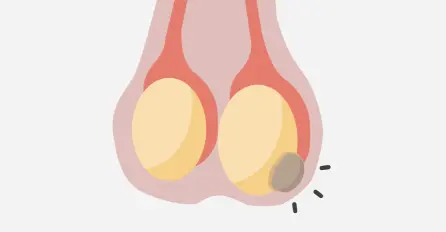What is testicular cancer?
Cancer is a disease in which your body’s cells grow out of control. When this abnormal cell growth starts in your nuts, it’s called testicular cancer.
Here are some key facts about testicular cancer:
There are different types of testicular cancer.
More than 90% of testicular cancers start in the cells that make sperm (germ cells).
The main types of germ cell cancers are seminomas and non-seminomas.
Treatment decisions and chances of recovery depend on the kind of cancer and the type of cell it starts in.

How common is testicular cancer?
Testicular cancer isn’t very common. Globally, it makes up less than 1% of all male tumors. But, it’s the most common cancer in young men. Fortunately, testicular cancer is highly curable when it’s found and treated early. That’s why it’s so important to know what’s normal (and what’s not) for your nuts, and head to the doctor if something’s not quite right.
Statistics from around the world
109,000
More than 109,000 men are diagnosed with testicular cancer each year.
10,000
At least 10,000 men die from testicular cancer each year.
836,000
Over 836,000 men are living with and beyond testicular cancer right now.
Who’s at risk for testicular cancer?
Anyone who has nuts can get testicular cancer. No one knows exactly what causes it, but there may be some related risk factors. In saying that, many guys who get it don’t have any of these known testicular cancer risk factors.
Possible testicular cancer risk factors
Undescended testicles at birth. (Your nuts didn't drop)
Being related to someone who’s had testicular cancer.
Having had testicular cancer before.
Race and ethnicity – risk is higher in the USA and Europe, and lower in Africa and Asia.
Knowing your nuts is key
The best thing you can do for your nuts is to get familiar with them on a regular basis. (Go on, have a feel.) The video below will guide you step-by-step on how to give your nuts a rub down, and it‘s pretty easy to do. If you think you’ve found something unusual – like a lump, swelling or pain – make an appointment with your doctor.
What if I've been diagnosed with testicular cancer?
Getting diagnosed with testicular cancer is tough. Make sure you get some support around you. Consider getting more than one doctor’s opinion, and then you’ll need to chat about treatment options.
Remember, you’re not alone in this.
Hear from MoBro Ben Bowers about his experience with testicular cancer.
Treatment
When it comes to treating testicular cancer, the treatment your doctor advises will depend on a few things, including the type and stage of your cancer, and essentially how early it’s been caught.
Treatment options may include:
Surgery— usually the first line of defense, and involves removal of the testicle with cancer (called an orchiectomy). The procedure is done under general anesthesia.
Radiation therapy (or radiotherapy)—mainly used for seminomas, or after surgery for cancer that has spread out of the testicles.
Chemotherapy—often used after surgery to treat any remaining cancer cells that may have spread to other parts of the body, such as lymph nodes.
RPLND (retroperitoneal lymph node dissection)—surgery to remove the lymph nodes at the back of the abdomen, where testicular cancer can spread.
Does testicular cancer affect fertility?
Thinking of having kids down the track? If you’ve had testicular cancer and a single testicle has been removed, you can likely still produce large numbers of sperm with your remaining testicle.
If you’re planning to start a family or have more kids at some point, talk to your oncologist about sperm freezing and banking before you have chemotherapy or radiation therapy.
Knowing your nuts is key
The best thing you can do for your nuts is to get familiar with them on a regular basis. (Go on, have a feel.) The video below will guide you step-by-step on how to give your nuts a rub down, and it‘s pretty easy to do. If you think you’ve found something unusual – like a lump, swelling or pain – make an appointment with your doctor.
